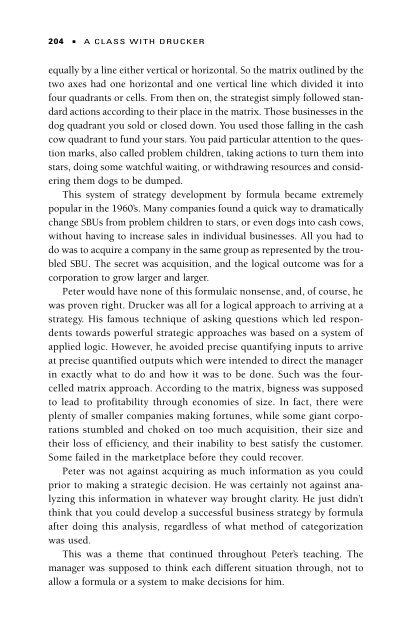A Class with Drucker - Headway | Work on yourself
A Class with Drucker - Headway | Work on yourself
A Class with Drucker - Headway | Work on yourself
Create successful ePaper yourself
Turn your PDF publications into a flip-book with our unique Google optimized e-Paper software.
204 ■ A CLASS WITH DRUCKER<br />
equally by a line either vertical or horiz<strong>on</strong>tal. So the matrix outlined by the<br />
two axes had <strong>on</strong>e horiz<strong>on</strong>tal and <strong>on</strong>e vertical line which divided it into<br />
four quadrants or cells. From then <strong>on</strong>, the strategist simply followed standard<br />
acti<strong>on</strong>s according to their place in the matrix. Those businesses in the<br />
dog quadrant you sold or closed down. You used those falling in the cash<br />
cow quadrant to fund your stars. You paid particular attenti<strong>on</strong> to the questi<strong>on</strong><br />
marks, also called problem children, taking acti<strong>on</strong>s to turn them into<br />
stars, doing some watchful waiting, or <str<strong>on</strong>g>with</str<strong>on</strong>g>drawing resources and c<strong>on</strong>sidering<br />
them dogs to be dumped.<br />
This system of strategy development by formula became extremely<br />
popular in the 1960’s. Many companies found a quick way to dramatically<br />
change SBUs from problem children to stars, or even dogs into cash cows,<br />
<str<strong>on</strong>g>with</str<strong>on</strong>g>out having to increase sales in individual businesses. All you had to<br />
do was to acquire a company in the same group as represented by the troubled<br />
SBU. The secret was acquisiti<strong>on</strong>, and the logical outcome was for a<br />
corporati<strong>on</strong> to grow larger and larger.<br />
Peter would have n<strong>on</strong>e of this formulaic n<strong>on</strong>sense, and, of course, he<br />
was proven right. <str<strong>on</strong>g>Drucker</str<strong>on</strong>g> was all for a logical approach to arriving at a<br />
strategy. His famous technique of asking questi<strong>on</strong>s which led resp<strong>on</strong>dents<br />
towards powerful strategic approaches was based <strong>on</strong> a system of<br />
applied logic. However, he avoided precise quantifying inputs to arrive<br />
at precise quantified outputs which were intended to direct the manager<br />
in exactly what to do and how it was to be d<strong>on</strong>e. Such was the fourcelled<br />
matrix approach. According to the matrix, bigness was supposed<br />
to lead to profitability through ec<strong>on</strong>omies of size. In fact, there were<br />
plenty of smaller companies making fortunes, while some giant corporati<strong>on</strong>s<br />
stumbled and choked <strong>on</strong> too much acquisiti<strong>on</strong>, their size and<br />
their loss of efficiency, and their inability to best satisfy the customer.<br />
Some failed in the marketplace before they could recover.<br />
Peter was not against acquiring as much informati<strong>on</strong> as you could<br />
prior to making a strategic decisi<strong>on</strong>. He was certainly not against analyzing<br />
this informati<strong>on</strong> in whatever way brought clarity. He just didn’t<br />
think that you could develop a successful business strategy by formula<br />
after doing this analysis, regardless of what method of categorizati<strong>on</strong><br />
was used.<br />
This was a theme that c<strong>on</strong>tinued throughout Peter’s teaching. The<br />
manager was supposed to think each different situati<strong>on</strong> through, not to<br />
allow a formula or a system to make decisi<strong>on</strong>s for him.


